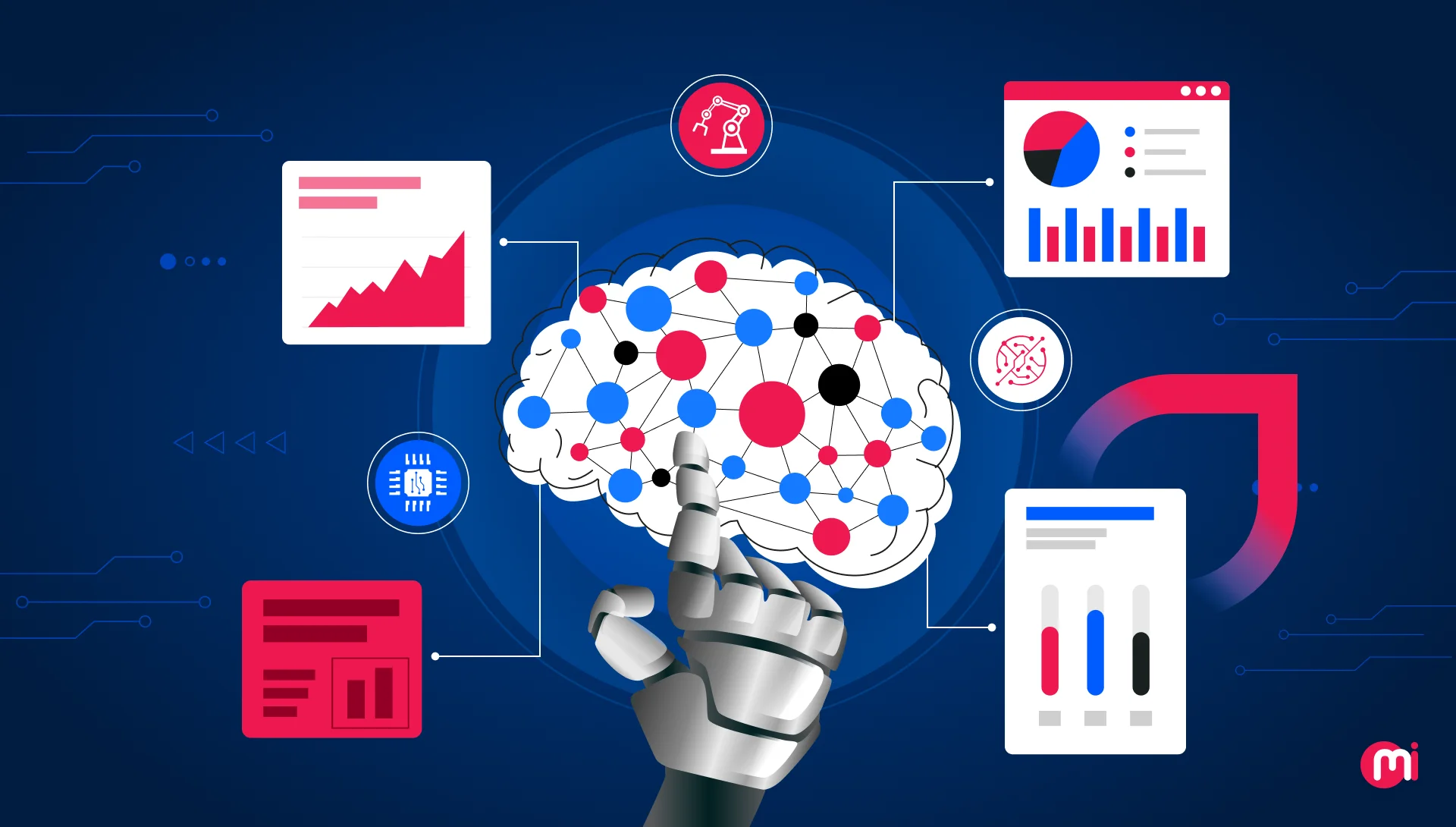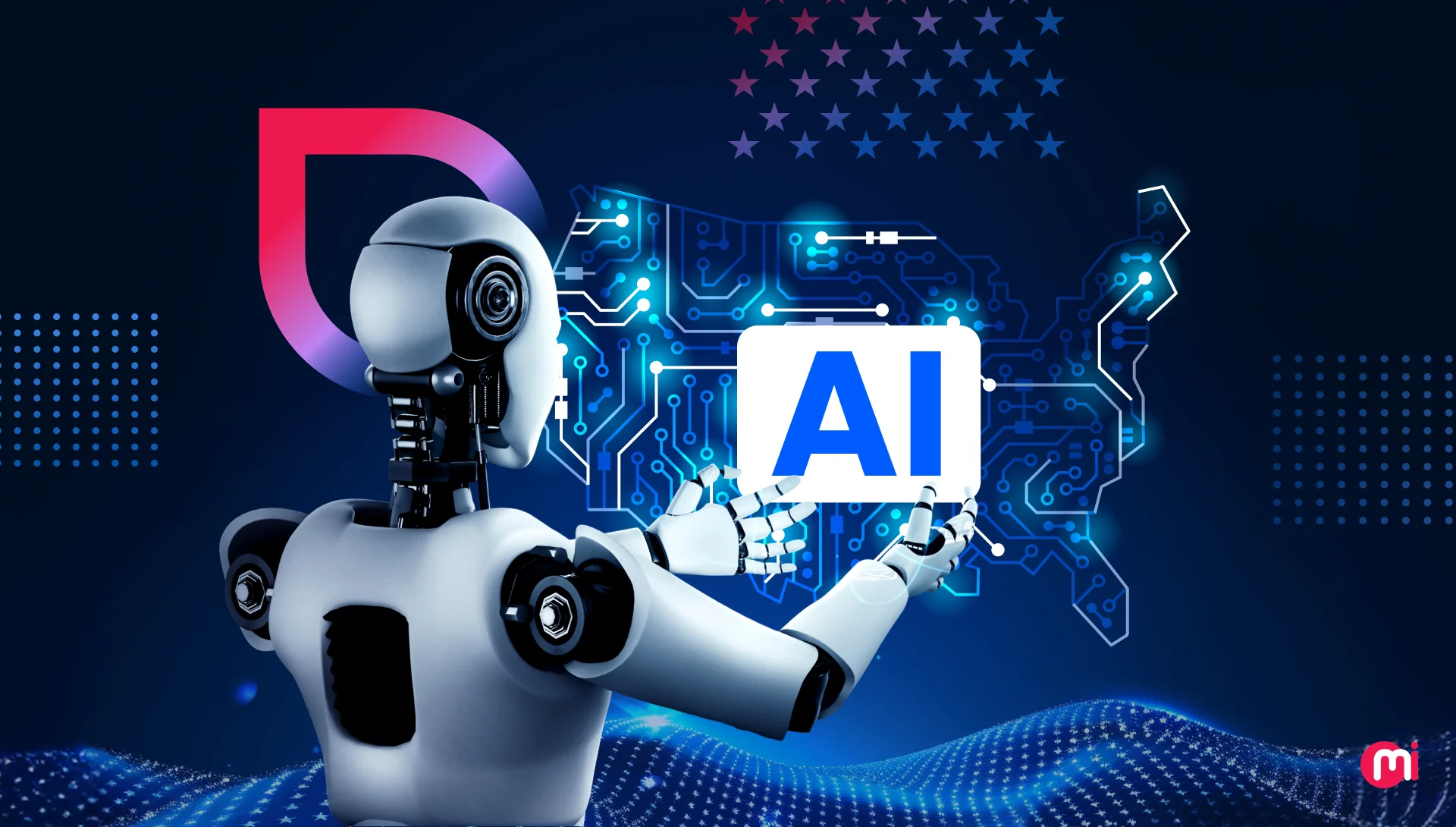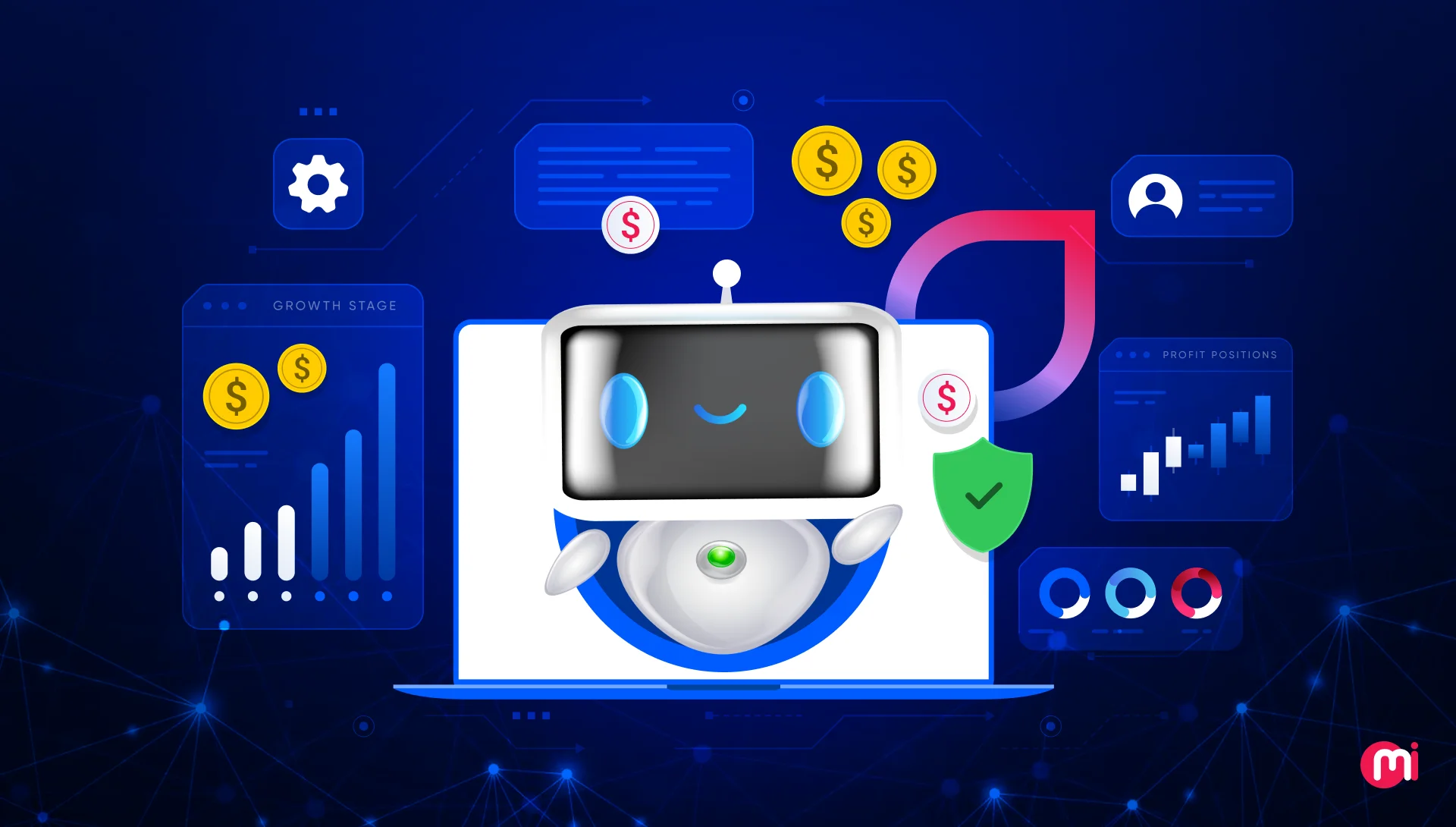Machine Learning Statistics 2025: Market Growth, Adoption, ROI, Jobs, and Future Trends
- AI/ML
- October 7, 2025
Machine learning empowers computers to learn from data and execute tasks without step-by-step programming, transforming it from a futuristic concept into a vital business tool, a thriving career path, and a global research frontier.
However, with so much data available, it’s hard to separate hype from actionable insights. In this blog, we break down the latest machine learning statistics for 2025, covering everything, including market size, adoption rates, businesses’ spending on ML development services, ROI for businesses, global talent demand, job opportunities for students, and more.
This blog covers all the latest updates and statistics about machine learning that you’re looking for.
Key Takeaways: Machine Learning Statistics You Need to Know
- Over 15% of businesses are already using or piloting machine learning solutions.
- Around 60% of businesses are using machine learning as their AI-driven growth enabler.
- Around 85% of machine learning projects fail, and poor data quality is the #1 reason.
- From diagnosing diseases to fraud detection and dynamic pricing, ML adoption is expanding fastest in these sectors.
- Around 79% of ongoing machine learning application-based projects are somewhere in the advanced stage of development.
- Around 80% of users implementing ML applications have confirmed to have a data governance framework in place.
- Businesses are seeing a reduction in difficulties in hiring machine learning engineers, a drop from 72% in 2023 to 63% in 2024.
What Is the Current Market Size and Growth of Machine Learning?
The current global market size of machine learning is $105.45bn and can grow to $568.32bn by 2031. The market size change for the period 2025-2031 is expected to be around 36.72%.
| The global machine learning market size is expected to rise to $309.68bn by 2032 at a CAGR of 30.5% for the forecast period 2025-2032. | Fortune Business Insights |
| The United States captures the largest machine learning market size, worth $30.62bn, which is higher compared to other countries. | Statista |
| The global machine learning as a service market size is projected to be around $1216bn by 2034. This marks an increase of 39.30% from 2024 to 2034. The major driving factors of its rise include cloud computing, AI, and cognitive computing. | Precedence Research |
| The current market size of MLOps is around $2.33bn and can reach up to $19.55bn by 2032. The market is expected to grow at a compounding rate of 35.5% for the forecast period 2025-2032. | Fortune Business Insights |
| The global machine learning in finance market size was last estimated at around $2.7bn in 2023 and can grow to $41.9bn by 2033 at a CAGR of 31.8%. | Market US |
| The global market size of AI/ML in the media and entertainment industry is expected to reach $198.42bn by 2032 at a CAGR of 31.9%. | Market Research Future |
| The market size of machine learning in the travel industry was last valued at $3.2bn in 2024 and can grow to $17.8bn by 2033 at a compound annual growth rate of 21.2%. | Market Intelo |
| In 2024, the U.S. generated 18.5% of global machine learning market revenues. | Grand View Research |
| North America captured 29% of the worldwide ML market revenues in 2024. | Grand View Research |
| Asia-Pacific contributed 27.6% of total global revenue in the machine learning sector in 2024. | Grand View Research |
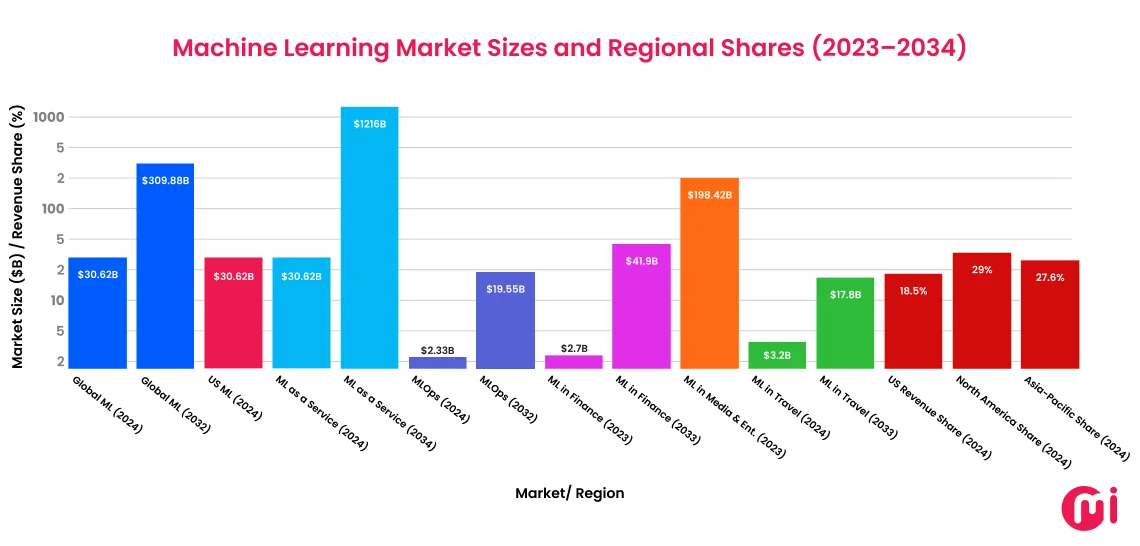
How Widely Is Machine Learning Adopted Across Industries?
Machine learning (ML) adoption is extremely widespread and is rapidly becoming a core component of operations across nearly all industries, with companies in sectors like financial services, healthcare, retail, and manufacturing leading the way in integration and investment.
- Financial services are leveraging ML for fraud detection, risk assessment, and algorithmic trading.
- Among many AI use cases in healthcare, many associated organizations are using ML in disease diagnosis, drug discovery, and improving patient care.
- Retail/E-commerce businesses are utilizing ML for personalized product recommendations, demand forecasting, and inventory management.
- Manufacturing firms are making the most of ML for predictive maintenance, quality control automation, and supply chain automation.
| Machine learning holds 45% of the global AI/ML stake in the drug development market. In this, Machine Learning will contribute to the analysis of large datasets to predict drug-protein interactions and identify potential products with accuracy at speed. | Towards Healthcare |
| Approximately 70% of financial services firms have adopted machine learning to enhance operational efficiency. They are doing it by automating routine data analysis. | Plat AI |
| Approximately 75% of respondents from the banking industry with assets worth over $100 billion are implementing AI strategies. | Business Insider |
| Machine learning models can help to predict risks with 93% accuracy, which is higher than the traditional models with 62.75% accuracy. | Plat AI |
| Around 80% of banks are aware of how AI and machine learning can benefit them. | Business Insider |
| Adopting machine learning for predictive maintenance can help to reduce facility downtime by 5-15%, increase labor productivity by 5-20%, reduce inventory levels by 10-30%, and more. | Deloitte |
| E-commerce platforms are widely leveraging machine learning to personalize customer experience by suggesting products they want to buy. This trend will be worth $2,412.3 million by 2033. | Global Trade Mag |
| 33% of commercial real estate firms are planning to invest in AI/ML capabilities in the next 2-3 years. Reading a blog on AI in real estate can help you know how. | Altus Group |
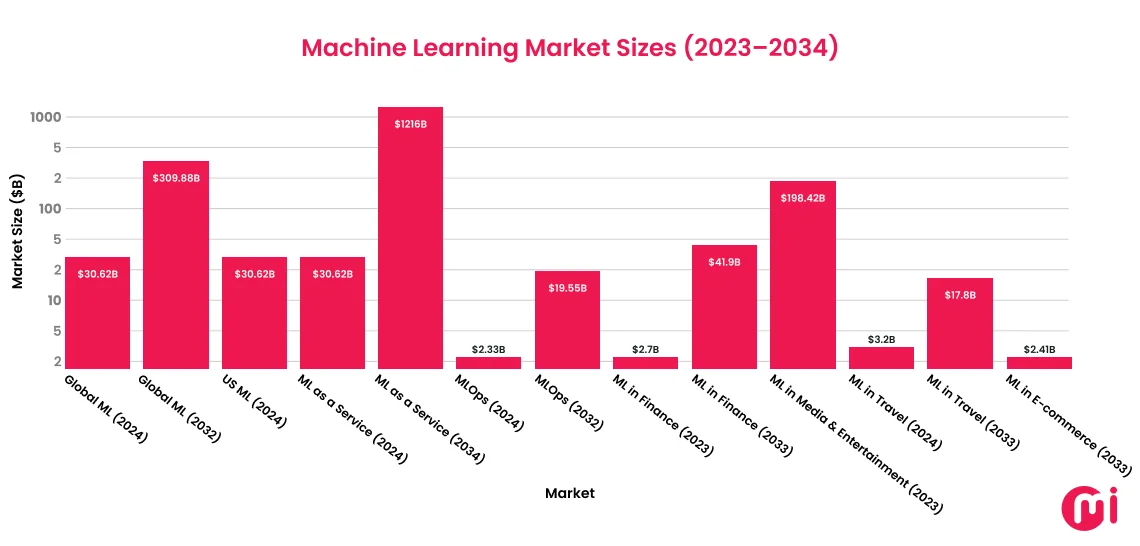
ALSO READ: AI Statistics: Trends, Risks, and Future Predictions (2025 Updates)
What Are the Major Factors Driving Companies to Adopt Machine Learning and AI?
Key drivers for Machine Learning (ML) adoption include increased data complexity, the drive for greater efficiency and automation, the growing demand for personalized solutions, and the rising accessibility of ML technologies.
| 42% of businesses adopt AI/ML tech to reduce costs and automate key processes. | IBM |
| 31% of businesses adopt AI/ML solutions due to competitive pressure. | Brandwell |
| Investment in AI/ML tech indeed offers great value in core business processes, but in this the leader’s decision behind this adoption generates 62% of the value. | BCG |
| As per the survey done with 1,500 manufacturing business leaders across 17 countries, around 41% are found to be adopting AI/ML tech to compensate for labor shortages. | Rockwell Automation |
| Over 80% of businesses are seen embracing the AI/ML trend to some extent because they see it as a core technology, primarily for chatbots, to enhance agent productivity and customer experience | GPTZero |
| 83% of executives claim that AI is a top priority in their business plans. | Forbes |
| 38% of companies are adopting machine learning to reduce costs. | Scoop Market |
| 34% of companies are adopting machine learning to improve customer experience. | Scoop Market |
| 25% of IT companies adopt machine learning for enhanced security. | Scoop Market |
| 16% of IT executives plan to use ML-powered tools for marketing and sales. | Scoop Market |
| 36% of commercial real estate firms are investing in ML, data science, and related tech for better competitive advantages. | Altus Group |
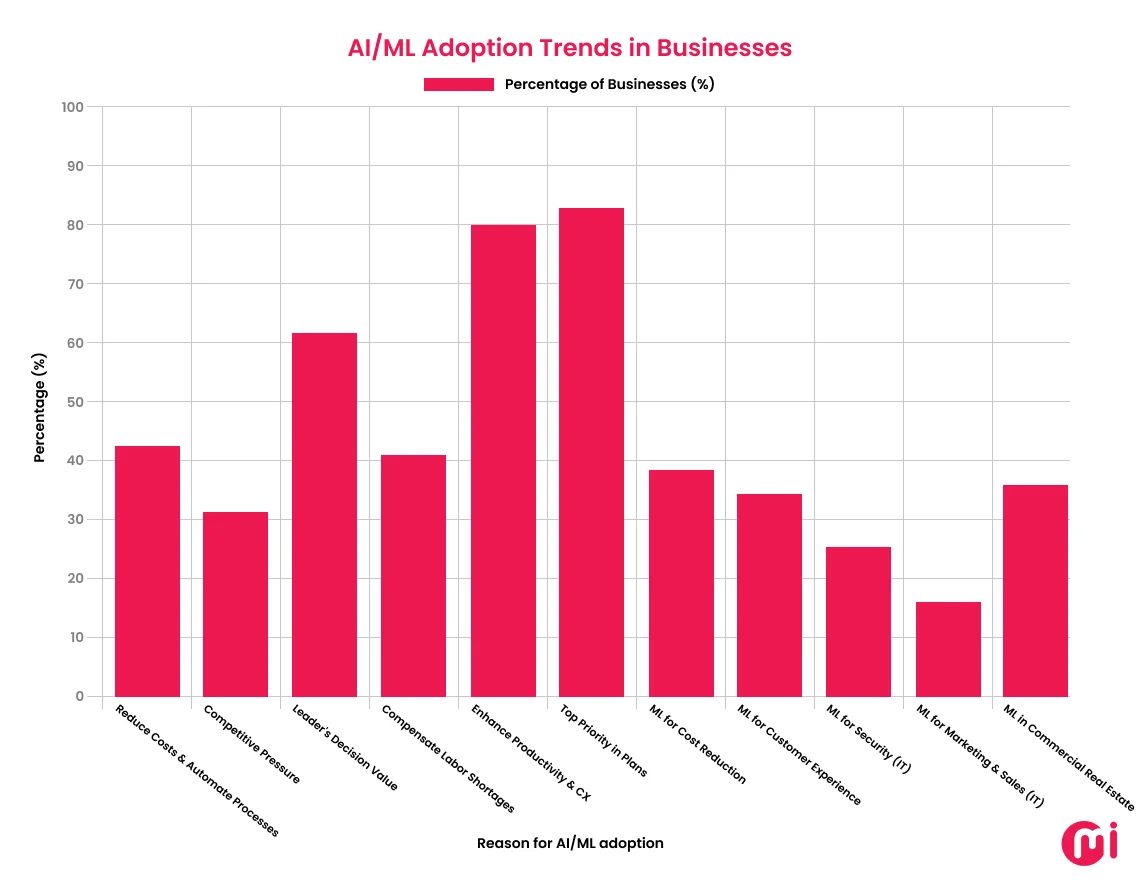
How Is Machine Learning Used Across Various Business Functions?
HR, sales, marketing, supply chain, and customer services are the top functions where machine learning is actively used.
- HR teams can leverage machine learning for talent analytics, performance analysis, and routine task automation.
- Sales teams can leverage machine learning capabilities for lead prioritization and sales forecasting.
- Marketing personnel leverage ML solutions for customer segmentation, personalized campaigns, and predictive analytics.
- Supply chain functions can leverage demand forecasting, inventory management, logistics optimization, and sustainability.
- Machine learning also contributes significantly to improving customer experience. It does so by powering personalized recommendations, predictive customer service, fraud detection, and more.
| 56% of organizations now utilize machine learning in at least one business function to optimize performance. | McKinsey |
| 97% of companies using AI and machine learning report productivity increases. | Pluralsight |
| AI/ML-driven automation can drive up to 50% cost reductions across shop floors and the supply chain. | BOSCH |
| Leveraging Generative AI in manufacturing can help to increase productivity by 2-3X, improve service levels by 50%, and decrease energy consumption by 30%. | BOSCH |
| Approximately 80% of companies are leveraging AI/ML technologies to improve customer service. | Gartner |
| Machine learning minimizes errors and streamlines processes, while AI tools such as chatbots can lift productivity by as much as 54%, delivering round-the-clock performance. | Erlang Solutions |
| The HR Analytics market, which uses ML, was valued at $2.50 billion in 2023 and is expected to grow to $5.92 billion by 2030. | Skill Logic |
| 51% of the surveyed individuals from the HR industry mentioned that they plan to incorporate AI and Machine Learning as primary technologies within the next one to five years. | Data Science Central |
| AI-driven personalization can increase customer retention by 15%. | Influencer Marketing Hub |
| ML-driven predictive maintenance reduces unplanned downtime by 30-50%. This leads to saving millions in operational costs. | McKinsey |
| 31% of respondents say that ML adoption for sales and marketing functions has offered positive results. | Intuition |
| 27% of businesses leverage machine learning to detect and reduce fraud in their operations. | Scoop Market US |
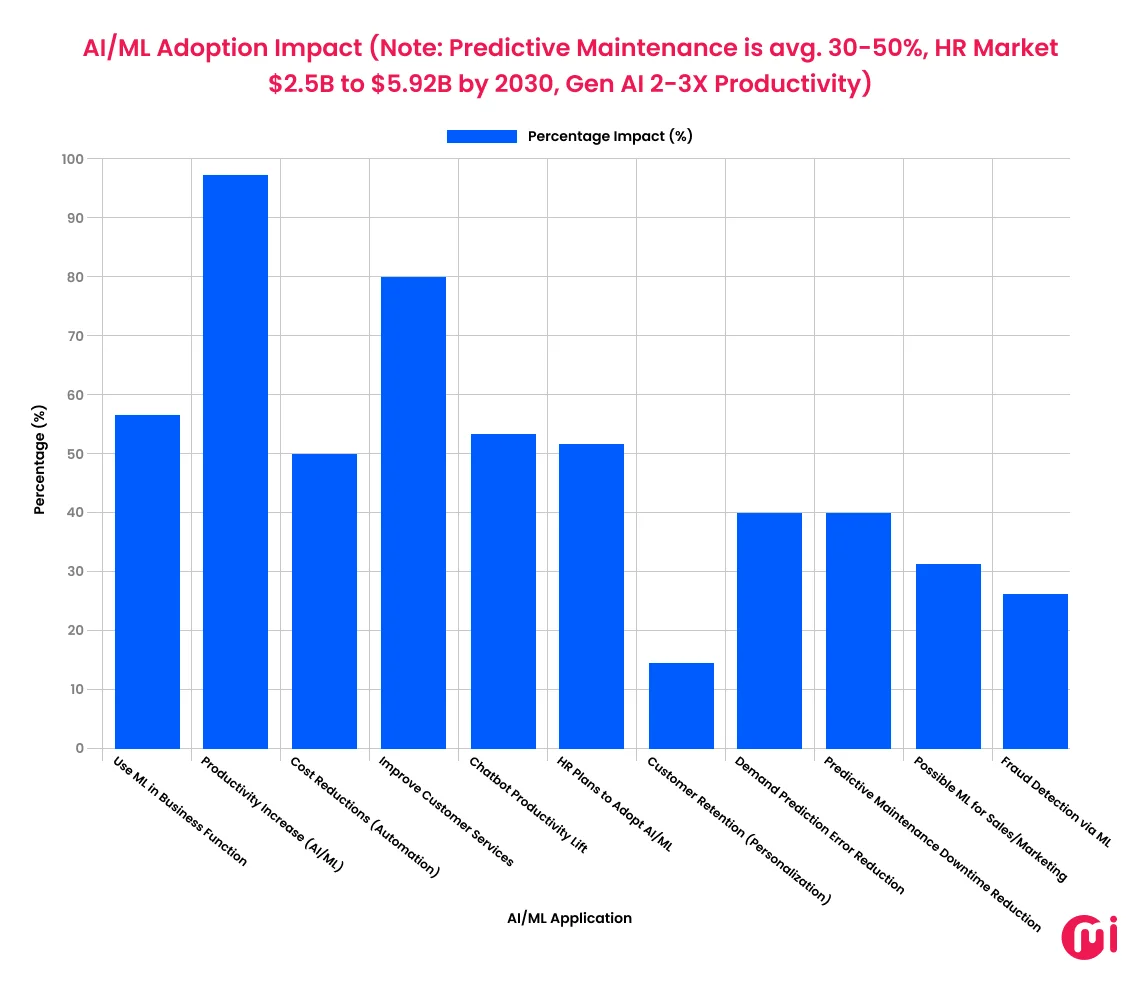
What ROI and Business Impact Does ML Deliver?
Machine Learning (ML) delivers ROI and business impact by reducing costs through task automation, increasing revenue via enhanced customer insights and targeted marketing, and improving operational efficiency through faster, data-driven decision-making.
| Organizations with AI/ML strategies in place see a 10-20% improvement in ROI. | Amra Elma |
| Those who automate their marketing operations through ML solutions achieve 544% ROI. | Amra Elma |
| 9% of manufacturing companies say that adopting AI and ML solutions has benefited them in terms of budget and time. | Intuition |
| ML-powered intelligent automation can help organizations save costs up to 31% in the next three years. | Deloitte |
| 42% of companies said that after seeing the ROI from AI and ML initiatives, their expectations from this tech have been exceeded. | Accenture |
| Due to rising demand for AI and ML solutions among consumers, total economic gains are expected to increase to 40.6% by 2030 for North America and China and 31.5% for the Europe and Developed Asia region. | PwC |
| Organizations view AI and machine learning as a strategic investment to future-proof their business, enabling them to meet rising customer demands and address operational challenges. | Intuition |
| American Express has witnessed a 30% reduction in fraud losses due to the deployment of machine learning for predictive analytics. | Forbes |
| The adoption of cutting-edge finance automation solutions has led to substantial cost savings, reportedly around 70% in finance operations costs. | Market US |
| Netflix saves $1 billion/year thanks to its investment in machine learning. | Scoop Market US |
| The use of machine learning in Neural Machine Translation is helping Google to reduce errors by at least 60%. | digit |
| European banks have seen a significant 10% increase in sales of new products and a 20% decline in churn after they replaced statistical techniques with machine learning. | Mckinsey |
| Retailers that adopted AI and ML in 2023 and 2024 reported around 8% annual profit growth. Plus, they are consistently outperforming peers that stayed away from these technologies. | Statista |
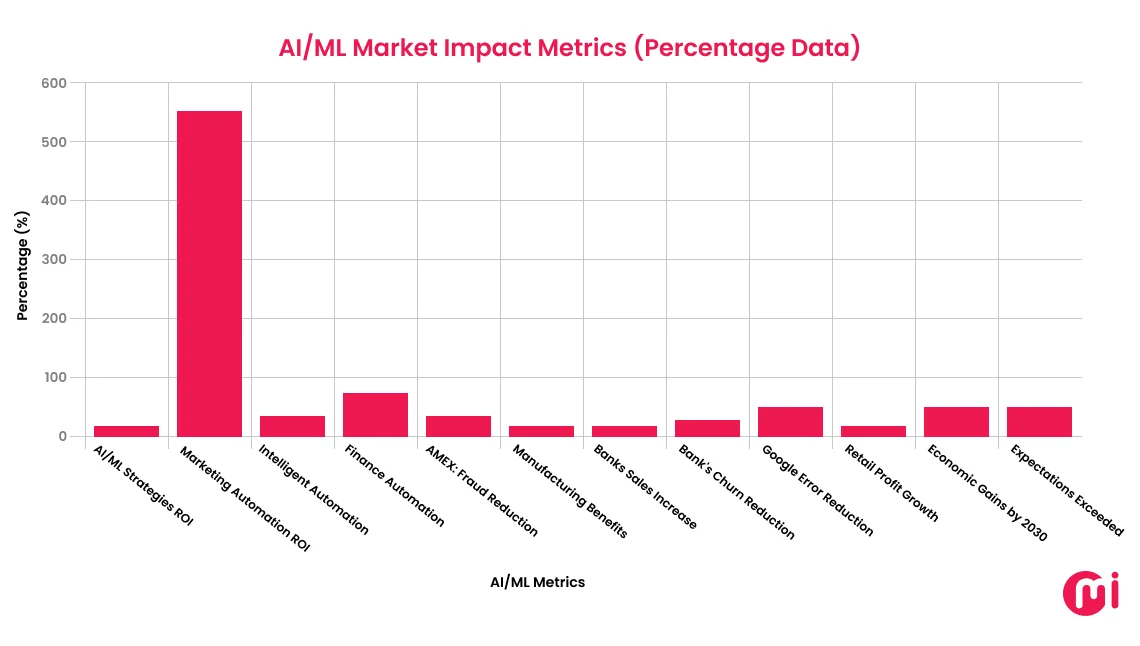
Where Is the Demand for ML Talent Growing, and Which Countries Lead in Machine Learning Expertise?
Demand for Machine Learning (ML) talent is growing across virtually every industry but is most concentrated in major technology hubs like the United States, India, and parts of Europe.
| LinkedIn Job search shows 207,000+ openings worldwide for the machine learning role. | |
| The current global AI/ML workforce employs around 1.6 million people, with an increase of over 219,000 professionals in the past year alone. | StartUs Insights |
| India shows the most dramatic growth, with 2.3 million AI professionals to be there by 2027, which shows a 55% year-over-year increase. | Bain & Company |
| India will have 1.2 million qualified AI/ML candidates. | Bain & Company |
| In the US, chances are that every 1 in 2 AI jobs will be left unfilled by 2027. | Bain & Company |
| Over the next three years, the UK could face a shortage of 150,000 AI professionals, while Australia may fall short by 60,000. | Bain & Company |
| 57.7% of machine learning engineer job postings demand domain experts rather than versatile generalists. | 365datascience |
| Every 1 in 3 ML engineer job listings mentions AWS. | 365datascience |
| 36.2% of machine learning engineer job posts demand candidates to have a PhD. | 365datascience |
| 23.9% of ML engineer job posts don’t even mention any specific degree. They prefer ML skills over degrees and certifications. | 365datascience |
| 20% of small business finance teams say that there are still skill gaps in using AI and ML tools. | Vena Solutions |
| Job trend for the ML role is growing faster with 13.1% quarter-over-quarter, which will be around 41.8% YoY. | Veriton |
| Based on the Q1 2025 survey around the U.S. labor market, there were around 143,000 jobs open in January, 128,000 in February, and 228,000 in March. | Veriton |
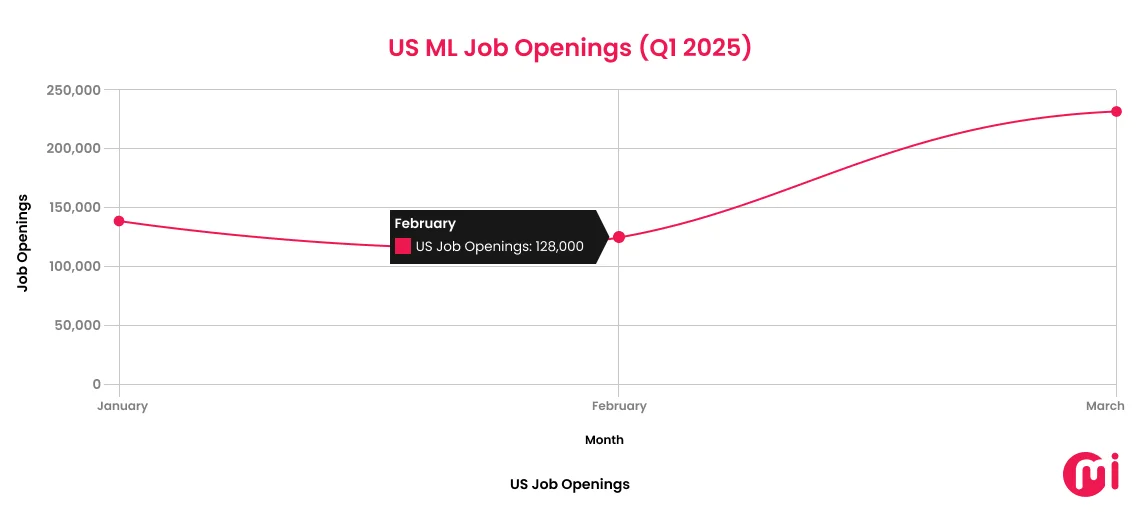
How Much Do Machine Learning Engineers Earn?
If we see the global insight on machine learning engineer salary, then they typically earn around $90,000 to $300,000+ USD annually. However, the salary range can vary depending on factors like location, years of experience, technical skills, and the employer.
| In Switzerland, machine learning engineers earn around $131,860 (123,704 CHF) annually. | CareerFoundry |
| In the United States, machine learning engineers earn around $127,301 annually. | CareerFoundry |
| In Australia, machine learning engineers earn around $103,005 (AUD $155,778) annually. | CareerFoundry |
| In Germany, machine learning engineers earn around $101,216 (€95,880) annually. | CareerFoundry |
| In Canada, machine learning engineers earn around $93,915 ($129,633 CAD) annually. | CareerFoundry |
| In the United Kingdom, machine learning engineers earn around $83,633 (£70,422) annually. | CareerFoundry |
| In India, machine learning engineers earn around $56,320 (₹50,00,000) annually. | Glassdoor |
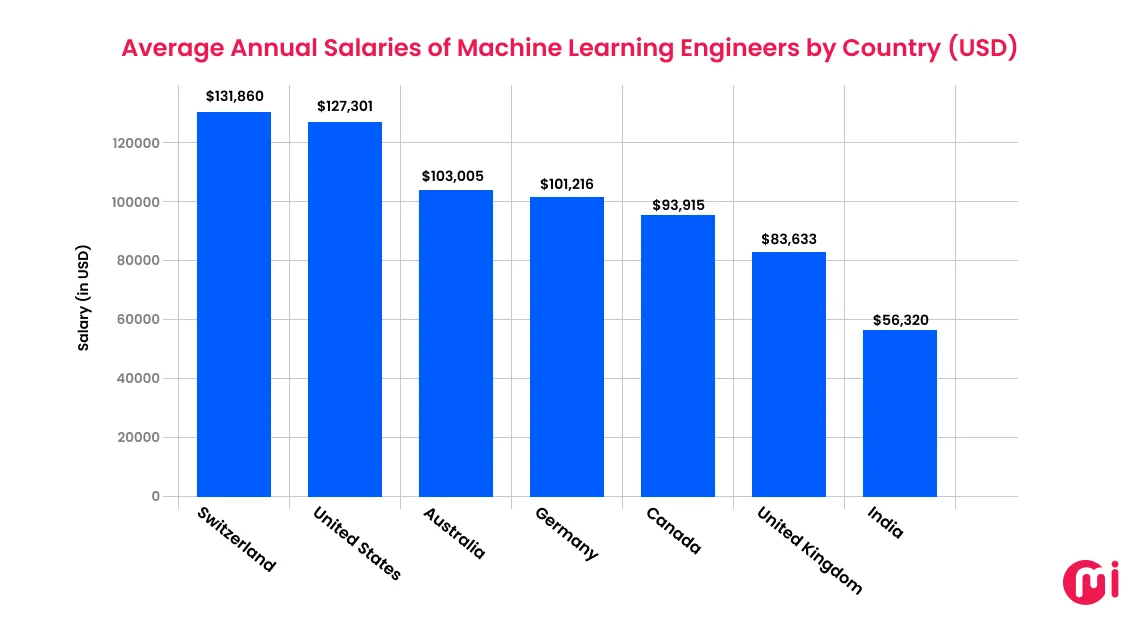
What Are the Latest Outsourcing Trends for ML Talent?
The latest outsourcing trends for Machine Learning (ML) talent are driven by a persistent global skills shortage and the rapid evolution of AI technologies, especially generative AI. To fill this gap, businesses are adopting new strategies, moving beyond traditional cost-saving models toward specialized, hybrid, and ethical partnerships.
| Approximately 52% of companies outsource their AI and Machine Learning consulting. | Deloitte |
| 34% of companies outsource their Robotics Process Automation (RPA) efforts to external partners. | Deloitte |
| 52% of companies outsource their data & analytics projects to external providers. | Deloitte |
| 50% of organizations admit they’re not ready to handle upcoming tech skill shortages, especially in advanced cybersecurity, data science, and AI/ML. | Deloitte |
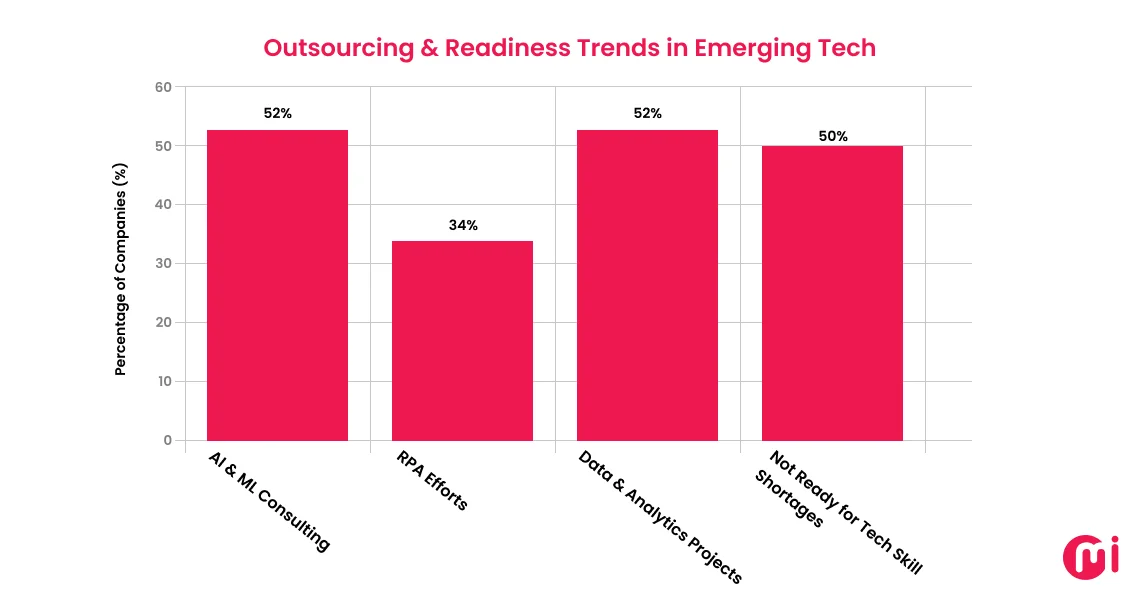
How Much Are Companies Spending on ML Projects?
Companies are spending under $100,000 for basic ML solutions and over $1,000,000 for advanced, large-scale, or custom initiatives. However, the cost can vary depending on the project’s complexity, data requirements, hardware needs, and the cost of skilled talent.
| Around 88% of enterprises have allocated a specific budget to AI/ML development solutions, and 15% of their budget is specifically designated for AI initiatives. | Nasscom |
| 95% of leaders say their firm is investing in AI and the number of companies spending $10 million or more on it is set to nearly double from 16% to 30% over the next year. | EY |
| 54% of mid-to-large companies are allocating at least 25% of their IT budget for AI/ML projects in the future. This also includes leveraging AI/ML capabilities in enterprise software development. | EY |
| AI in retail spending was marked at around $25 billion in 2024, thanks to its use case – personalized shopping experiences achieved through machine learning and data analytics. | IDC |
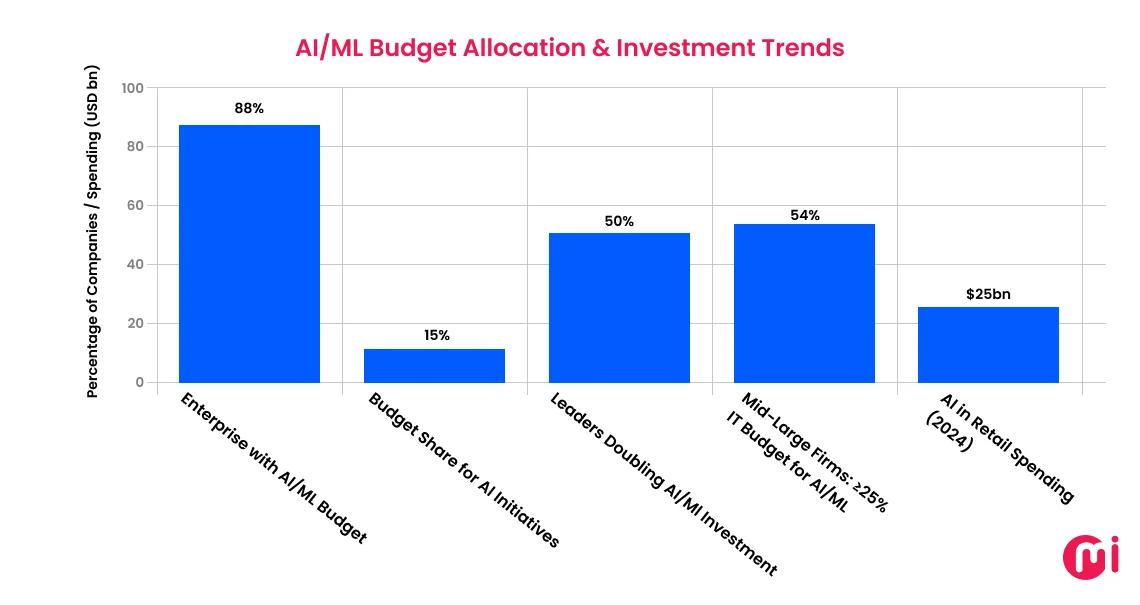
What Future Trends Will Shape ML in the Next 3-5 Years?
The future of machine learning will be all about autonomous AI agents, multimodal learning, pervasive edge AI, responsible AI, and explainable AI (XAI).
| 100+ global enterprises across 8-9 regions and 10+ industries are mapping the enterprise shift from experimental GenAI to strategic human-AI agent development solutions. | Entrepreneur |
| 62% of global enterprises are actively piloting AI agents, from early proof-of-concepts to full-scale deployments. | Entrepreneur |
| 50% of companies using Generative AI will launch their agentic AI pilots by 2027. | Deloitte |
| In the past two years, investors have lent over $2bn to agentic AI startups. | Deloitte |
| The global multimodal AI market is estimated to grow at a CAGR of 32.7%, reaching a market value of $27bn, from 2025 to 2034. This trend is rising due to rising automation demands, rising customer experience expectations, increased demand for AI in security, and more. | Global Market Insights |
| Companies that allocate more than 10% of their AI budget to responsible AI are twice as likely to achieve advanced operational maturity and three times as likely to reach higher generative AI maturity. | Accenture |
| 78% of companies have a responsible AI program in place. Of these, 14% are actively putting responsible AI into practice, while 8% are just starting by defining responsible AI principles. Soon, there’ll be a company that will pioneer this. | Accenture |
| The global Explainable AI (XAI) market was valued at USD 7.79 billion in 2024 and is expected to grow to USD 21.06 billion by 2030, at a CAGR of 18.0% between 2025 and 2030. | Grand View Research |
Conclusion
These latest machine learning statistics clearly highlight ML as a strategic imperative. By examining adoption trends and investment patterns, businesses that leverage ML effectively can gain measurable advantages in efficiency, innovation, and decision-making.
For organizations just beginning their ML journey, understanding this data is crucial to investing wisely and maximizing ROI. The companies that move decisively today will define the market tomorrow.

FAQs About Machine Learning
Businesses can start seeing initial ROI from machine learning within 30-90 days for simpler automation projects, but complex implementations may take 6-12 months. You can see significant ROI after 12-18 months of the ML implementation. ROI time can vary depending on implementation complexity, data quality, and organizational change management.
A mid-sized company can start with a machine learning project by investing $20,000-$80,000 for a basic ML solution.
Yes, small businesses increasingly benefit from machine learning by achieving comparable gains in efficiency, cost reduction, and data-driven decision-making as large enterprises, thanks to democratized and affordable tools.
Companies often make mistakes at the start of ML projects by lacking clear goals, focusing on poor or insufficient data, underestimating the need for skilled personnel, and failing to properly evaluate model performance. Apart from these, they also make mistakes by expecting unrealistic results, ignoring ethical considerations, not factoring in the need for ongoing monitoring, and choosing the wrong algorithms or not having a clear deployment strategy.
The most in-demand programming language for machine learning jobs is Python.
The United States, China, the United Kingdom, India, Canada, Japan, France, and Germany are the countries that are investing the most in machine learning startups.
There are over 190,000 global applications for AI patents, of which 28% are classified as GenAI. These AI patent classifications cover technologies like machine learning, artificial neural networks, natural language processing, and computing based on biological models.
Machine learning will significantly impact non-tech jobs by automating routine tasks, leading to displacement in some roles and augmentation in others, while simultaneously creating new opportunities that demand human-centric skills like critical thinking, creativity, and interpersonal interaction.
No, machine learning will not replace traditional software development but rather will significantly transform it by acting as a powerful tool to automate tasks, enhance productivity, and shift developers’ focus to higher-level skills like system architecture, critical thinking, and complex problem-solving.
No, machine learning is not sustainable with current practices due to its high energy consumption and computational demands. However, it can contribute to driving sustainability across sectors by automating certain tasks.
In the next five years, machine learning will significantly disrupt healthcare, finance, retail, and logistics through automation, personalized services, and data-driven insights, while also impacting transportation with autonomous systems and knowledge work industries like tech and law by automating complex tasks.
Machine learning is a specific subset of AI that enables systems to learn from data, identify patterns, and improve their performance over time.
